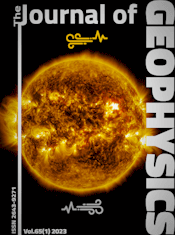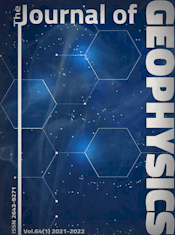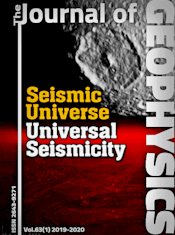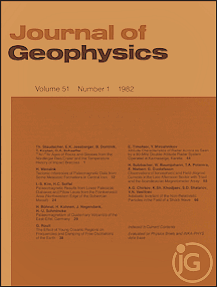Gravity and a model of the median valley
Article Sidebar

Vols. 1-18 (1924-1944), ISSN 0044-2801
Main Article Content
Abstract
The average median valley of the Mid-Atlantic Ridge between 12° and 18° N is described as a smooth depression flanked on both sides by a high. This applies both to the bathymetry and to the gravity anomalies. This picture of the median valley and its walls was obtained by stacking profiles across the valley in 50- to 70-km-wide bands. The reduced median valley can then be interpreted as the result of the parting of the lithosphere and the response of the asthenosphere as a viscous layer to repeated unloading. Fluid dynamic equations show that the response is in general broader than the original load disturbance. We describe this as a viscous lag of the shorter wavelength components. A steady-state solution was reached by numerical methods, showing a depression accompanied by a high on both sides. For the asthenosphere under the Mid-Atlantic Ridge at these latitudes a value followed for the kinematic viscosity of 1.5 x 1019 stokes. The model can be extended to other parts of the mid-ocean ridge system by adapting the time-dependent constants (viscosity and spreading rate). If the viscosity is a factor 5 lower, no median valley results. Rising to isostatic equilibrium of a light body under the floor of the median valley then accounts for the existence of a median ridge like found at Reykjanes Ridge and at the East Pacific Rise. The coefficient of viscosity under the East Pacific Rise would be about 0.4 x 1018 stokes. The concept of a viscous lag of the short-wavelength components replaces Sleep's (1969) original notion of a 'loss of head'. The secondary valleys and ridges found in the median valley and on the flanks of the Mid-Atlantic Ridge crest cannot be explained by the model. They represent essentially a non-continuum process, in which presumably an episodic jumping of the inner valley plays an important role. Additional faulting occurs at the hinge line between the floor and the walls of the median valley.
 ARK: https://n2t.net/ark:/88439/y006206
ARK: https://n2t.net/ark:/88439/y006206
Permalink: https://geophysicsjournal.com/article/106
Article Details
References
Cochran, J.R. (1979) An analysis of isostasy in the world's oceans: Part 2. Mid-Ocean Ridge crests. J. Geophys. Res. 84:4713-4729
Cochran, J.R., Talwani, M. (1977) Free-air gravity anomalies in the world's oceans and their relationship to residual elevation. Geophys. J. R. Astron. Soc. 50:495-552
Cochran, J.R., Talwani, M. (1978) Gravity anomalies, regional elevation, and the deep structure of the North Atlantic. J. Geophys. Res. 83:4907-4924
Collette, B.J., Rutten, K., Schouten, H., Slootweg, A.P. (1974a) Continuous seismic and magnetic profiles over the Mid-Atlantic Ridge between 12° and 18° N. Mar. Geophys. Res. 2:133-141
Collette, B.J., Schouten, H., Rutten, K., Slootweg, A.P. (1974b) Structure of the Mid-Atlantic Ridge province between 12° and l8°N. Mar. Geophys. Res. 2:143-179
Collette, B.J., Slootweg, A.P., Twigt, W. (1979) Mid-Atlantic Ridge crest topography between 12° and 15° N. Earth Planet. Sci. Lett. 42:103-108
Courtillot, V., Tapponnier, P., Varel, J. (1974) Surface features associated with transform faults: a comparison between observed examples and an experimental model. Tectonophysics 24:317-329
Fowler, C.M.R. (1976) Crustal structure of the Mid-Atlantic ridge crest at 37° N. Geophys. J. R. Astron. Soc. 47:459-491
Heiskanen, W.A., Vening Meinesz, F.A. (1958) The Earth and its gravity field. McGraw-Hill, New York
Lachenbruch, A.H. (1973) A simple mechanical model for oceanic spreading centers. J. Geophys. Res. 78:3395-3417
Lachenbruch, A.H. (1976) Dynamics of a passive spreading center. J. Geophys. Res. 81:1883-1902
Laughton, A.S., Searle, R.C. (1979) Tectonic Processes on Slow Spreading Ridges. 2nd Maurice Ewing Symposium, Am. Geophys. Union (In press)
Laughton, A.S., Searle, R.C., Roberts, D.G. (1979) The Reykjanes Ridge crest and the transition between its rifted and nonrifted regions. Tectonophysics 55:173-179
Luyendyk, B.P., Macdonald, K.C. (1977) Physiography and structure of the inner floor of the FAMOUS rift valley: Observations with a deep-towed instrument package. Bull. Geol. Soc. Am. 88:648-663
Menard, H.W., Atwater, T. (1968) Changes in direction of sea-floor spreading. Nature 219:463-467
Needham, H.D., Francheteau, J. (1974) Some characteristics of the rift valley in the Atlantic Ocean near 36°48' North. Earth Planet. Sci. Lett. 22:29-43
Peter, G., Merrill, G., Bush, S. (1973) Caribbean Atlantic Geotraverse. NOAA-IDOE 1971, Report No. 1, Project Introduction. Bathymetry
Ramberg, LB., Gray, D.F., Raynolds, R.G. (1977) Tectonic evolution of the FAMOUS area of the Mid-Atlantic Ridge, lat 35° 50' to 37° 20' N. Bull. Geol. Soc. Am. 88:609-620
Rea, D.K. (1978) Spreading-center offsets that are not transform faults. Eos. 59:370
Searle, R.C., Laughton, A.S. (1977) Sonar studies of the Mid-Atlantic Ridge and Kurchatov Fracture Zone. J. Geophys. Res. 82:5313-5328
Sleep, N.H. (1969) Sensitivity of heat flow and gravity to the mechanism of sea-floor spreading. J. Geophys. Res. 74:542-549
Sleep, N.H. (1975) Formation of oceanic crust: some thermal constraints. J. Geophys. Res. 80:4037-4042
Sleep, N.H., Biehler, S. (1970) Topography and tectonics at the intersections of fracture zones with central rifts. J. Geophys. Res. 75:2748-2752
Sleep, N.H., Rosendahl, B.R. (1979) Topography and tectonics of midoceanic ridge axes. J. Geophys. Res. 84 (In press)
Slootweg, A.P. (1978) Computer contouring with a digital filter. Mar. Geophys. Res. 3:401-405
Talwani, M. (1970) Gravity. In: Maxwell, A.E. (Ed.) The sea, vol. 4 Part 1, pp. 251-297. Wiley-Interscience, New York
Talwani, M., Le Pichon, X., Ewing, M. (1965) Crustal structure of mid-ocean ridges. 2. Computed model from gravity and seismic refraction data. J. Geophys. Res. 70:341-352
Talwani, M., Windish, C.C., Langseth, M.G., Jr. (1971) Reykjanes ridge crest: A detailed geophysical study. J. Geophys. Res. 76:473-517
Tapponnier, P., Francheteau, J. (1978) Necking of the lithosphere and the mechanics of slowly accreting plate boundaries. J. Geophys. Res. 83:3955-3970, 4497








